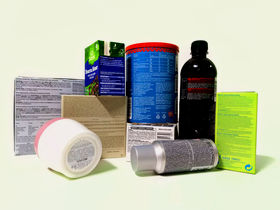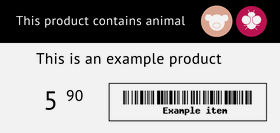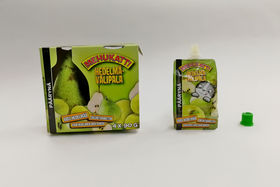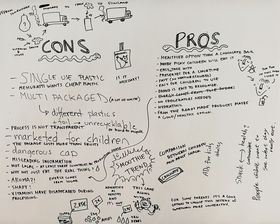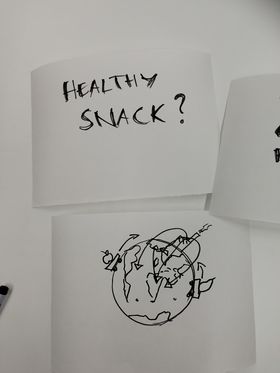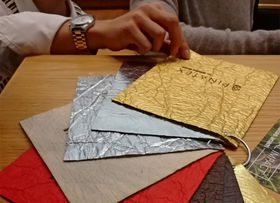Animal as a resource

About our project and group
Our group focused on the topic Animal as a resource. We brought this issue up as we all agreed it is both environmentally and ethically questionable issue. We have been using animal products ourselves. Humankind has grown into the idea that the animal is a property to human and we are above the all other species. The knowledge, the current time, the news and the climate change has drawn us here to challenge the idea. The relationship between human and animals has also been an ongoing topic for decades and now we understand that we cannot be the only species on the planet who live here and respect that. This was the driver to our research project. We wanted to create project that has some influence.
Our group consists of three design students from different backgrounds. Maria Ahti is a MA student from Fashion Design. Niina Hyry and Iines Jakovlev are MA students from Contemporary Design.
Raising awareness on animal based products
Article 12.10.2018
Our team project started with us defining most problematic things we felt would be important to change. Very quickly we started to express our concerns for wide use of animal based materials in daily life. This theme was not only important to us ethically but also because animal material industry is environmentally destructive and is a big donator for climate change. There seem to be no end for animal product consumption in near future and current global trend is that animal material consumption is coming more common in developing countries. So, how did we start our research? With a very small tag line: “Animal based materials”.
We didn’t want to limit ourselves so early on in the research so each team member looked into topics they felt were important. The research expanded very early on because the topic of animal based products is very wide and complex. In order to organize ourselves we needed something little bit more tangible for us to use. We started to make a list of all animal products we found while making our research and we had personal task to avoid animal based materials during the research and we kept each a personal diaries for how much we encountered and used animal products during this time.
(text continues after the image)
Raising awareness on animal based productsCurrently It would be impossible to live a life without any animal products.
Combination of all of the above made us realize that animal based ingredients have infiltrated to every aspect of our daily lie. Currently It would be impossible to life a live without any animal products. Once we had collected as much information on our topic as we could we started look for focus point for our project. Our initial problem was that how to create something that would have positive effect in consumer habits. We focused on what happens in the stores when people are shopping. How easy it is to recognise animal based ingredients and are all of them listed on the products? The answers are hard and no. A conscious consumer would need to memorize long list of E-numbers, names of chemical substances and be aware of ingredients that are not necessarily listed in products. The idea of the of E-numbers (codes of food additives that are permitted to be used in EU) and chemical substances having an effect of creating lack of transparency for consumer became our focus on this project.
To understand E-codes we interviewed Tuulikki Lehto from Evira to learn more about the E-codes and how they are used. She stated that Evira at the moment is only concentrated on safety issues and is not at the moment thinking about addressing more ethical perspectives of food consuming. There are also a lot of animal based ingredients that are not legally required to be listed on a product. Evira does have symbols for vegan foods and nationally produced foods but not one that covers products made out of animal ingredients. The vegan symbol is protected by Evira to be trustworthy symbol for consumers but according to her these kinds of changes are being demanded by activist groups. Researching on Evira made us to work on idea of creating transparency for animal based products, not only for food products but for all products.
(text continues after the image)

So, what would be our solution? We wanted to create some kind of informative system that people could make more educated purchases. It would need to be something that would deliver information more quickly and easily. We started to work on idea of creating new coding system for animal based ingredients. There is also not any coding system for products that contain animal materials at the moment. Evira at the moments uses vegan symbol for vegan products but there is no universal system for other products that contain animal materials. We felt that this new code would be useful for both conscious shoppers and those who don’t know about animal materials in products.
From creating new code we started to think new labelling system. In Alko there is already a labelling system for products e.g. how to pair wines with food but also labels for organic wines and plastic corks. We used Alko’s labelling system as a reference and we thought that with its clarity and familiarity it could be easily translated to our project. We created labels with easy symbols to represent the animal/animals used in products and we created a booklet where only animal based ingredients are listed.
(text continues after the image)
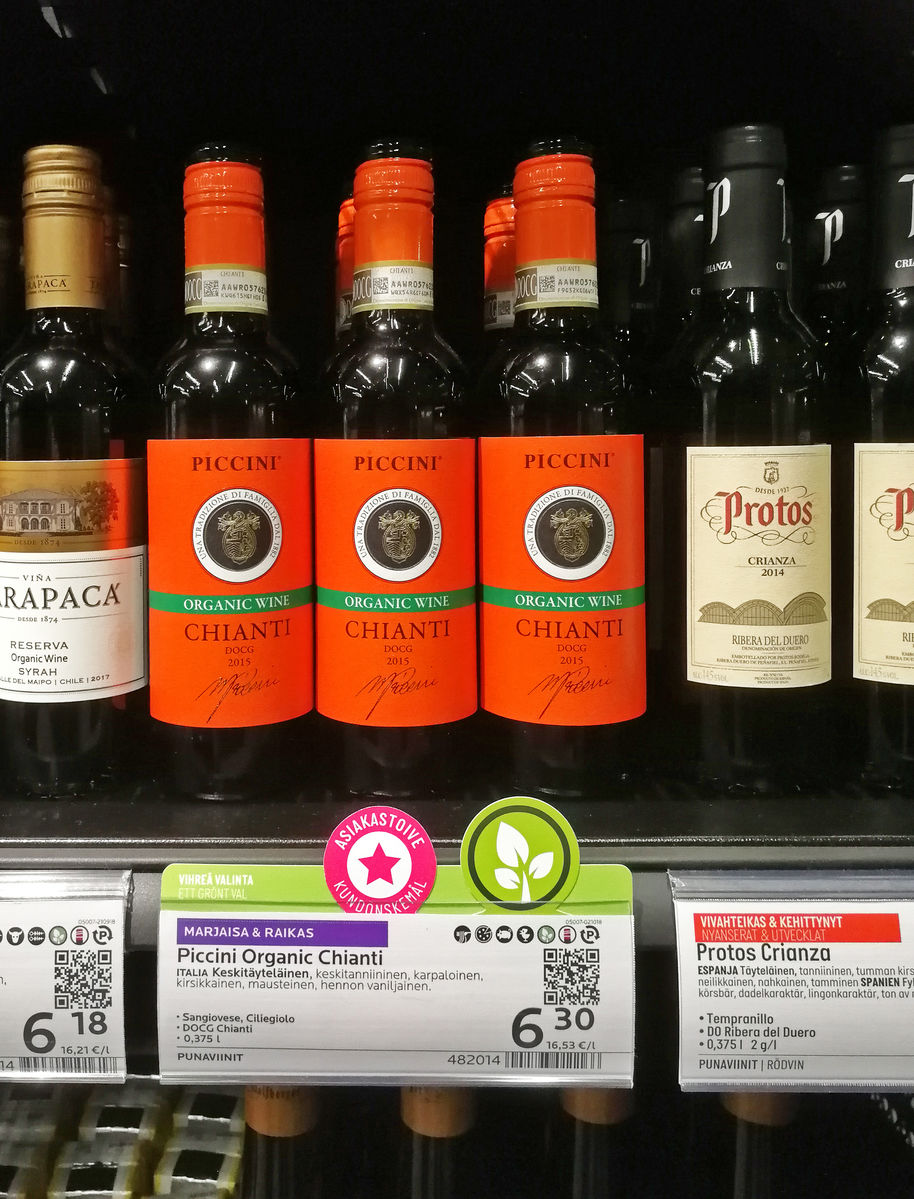
But who would use these? Producers probably wouldn’t want to use these because that could potentially scare away customers but how about stores? Nowadays there are many chains that have focused for serving ethically shopping customers and we felt that offering for them our label system would kick start a change for more transparency in animal based products. But having new labels for companies to use, would be only short time solution. On this current model, using our labels would still be on willingness of the companies. For our project to work we need legislate changes.
We have a plan to make steps to this direction. Our plan would be to affect from multiple fronts: One would be to share our label booklets to people who would want to have labelling for animal products and they could as conscious shoppers start to demand their nearest shops to use them. Second would be to offer our labels to willing companies to use. We would also need more credibility and back up to really have our labels in wide use one day. One part of our project would be to offer Evira to recognise these labels, support them and add them to their webpage. Third would be starting a citizen initiative that would force all companies to use these labels for their products.
Maria Ahti, 2018
...
Our Project Outcome: E-code Booklet
The Problem
We noticed that most of the ingredients were hiddened. E-codes were first created for showing admitted additives in products. At some point E-codes become a course word and consumers stated to avoid them, so companies started to use a longer names of ingredients.
Ingredient lists where usually in small print with difficult words you had no idea what they meant. Problem was also with the products that were not legally demanded to show the ingredient list. With some of these products you were able to find information from line, but most of them don't.
Now a days most products tell rather what is than not in them. No lactose, no gluten, no glutamate. We would like to focus on what's in rather than what's not. We want consumers to know and think of what they consume. We think that ingredients and processes should be more visible to consumers. With our project we want more people to think this way and maybe together we can make a change.
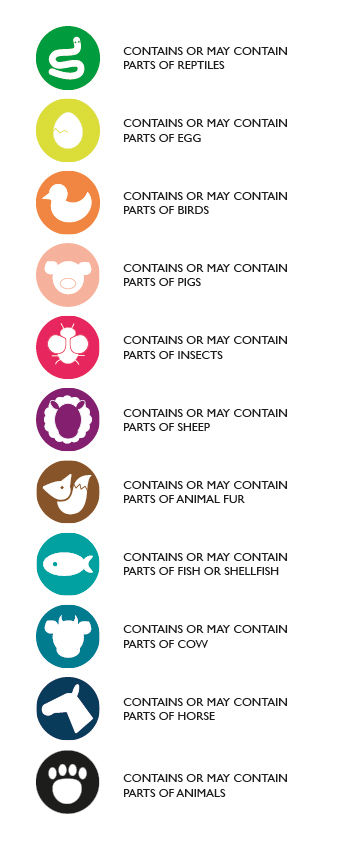
We created symbols for most common animals that are used in consumer products. Also we created a booklet where all the common animal based ingredients are listed.
We were thinking to offer these labels for people to who would want have this kind of label system and have them to demand from their nearest shops to use them. We would also offer our label package to shops that would like to use them.
By showing the products contents this type would affect also to those people who don't really care enough to find out themselves. We want these people to also think and maybe this way to change their behaviour to respect animal life more.


You can download and print this E-code booklet for free and use it when shopping.
Did you knew these products include animal based materials?
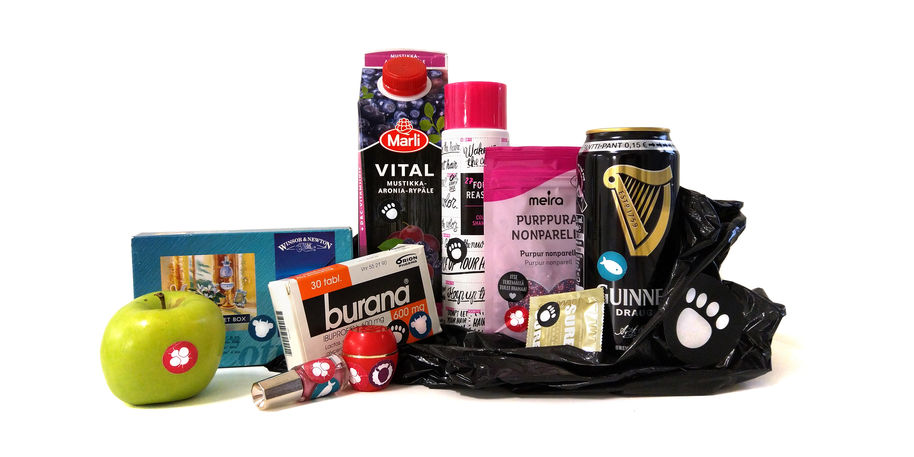
We went for shopping to find products that you may not think contains animal based products. Here is a collection of some of the products we found out include animal based products.
Orion Pharma Burana (ibuprofen) - includes lactose monohydrate, which is produced from milk. It is ingredient in many drugs. It also includes possible animal based polysorbate 80. The e-code for it is E433. Polysorbate 80 can be produced either animal of plant based fats. It is used as surfactant and emulsifier often in foods and cosmetics.
Winsor&Newton watercolors - Watercolours many times include ox gall, the dried extract of bovine gall bladders. It is a wetting agent widely used to give watercolors their famous liquid quality. In company web page you can find information about Winsor&Newton -products and which colours include ox gall and other ingredients. This is one good step towards transparency.
Mavala Shiny nail polish - Red colour in this nail polish comes from Carmine (E120), which is produced from some scale insects. This nailpolish also contains Guanine which is obtained from scales of fish and gives the colour shine.
Four reasons colour shampoo - Contains Keratin, which is protein produced from hooves, horns, and animal hair. It also includes glycerin which is produced from animal fats.
Oriflame tender care granberry - This multi use balm contains beeswax but in ingredient list it is under the name Cera Alba. It also includes lanoline, lamp wool grease.
Marli Vital Juice (blueberry, chokeberry, grapes) - In some juices gelatin is used in clarifying process but we don’t know how this juice in manufactured. This juice anyhow contains animal based D3 -vitamin.
Meira nonpareils - For this day we thought that nonpareils were only sugar, but there is also carmein as colorant and beeswax as surfactant.
SURE condoms - Condoms may contain milk protein casein and glycerin which can be produced either animal or plant fats.
Guinness beer - Guinness is now made with fish guts - but they are actually going to make them vegan soon.
Apple - Surprisingly some apples include beeswax cover. Sometimes shellac is also used, which is is a resin secreted by the female lac bug. In fruit production there is also different animal based pesticides used that may transfer into fruit.
Plastic bag - We can't be sure whether or not there is actually animal based materials, such as slip agents or softeners, in this plastic bag, there is a big chance for that. Same is in all other everyday products that don’t need to have ingredient list on them
Task: 10 Designer Examples
We had to choose 10 designer projects similar to our approach to animal as a resource project. We found few interesting examples and we categorize them in different fields as listed below.
Educational
http://www.wedonteatanimals.com
Soft values and uncomfortable truth
https://www.bbc.co.uk/bbcthree/article/84d43201-25bf-487b-807f-1aab5609e805
Realistic adaptation
Synthetic Biology
https://www.kukuangyi.com/tiger-penis-project.html
https://www.daisyginsberg.com/work/designing-for-the-sixth-extinction
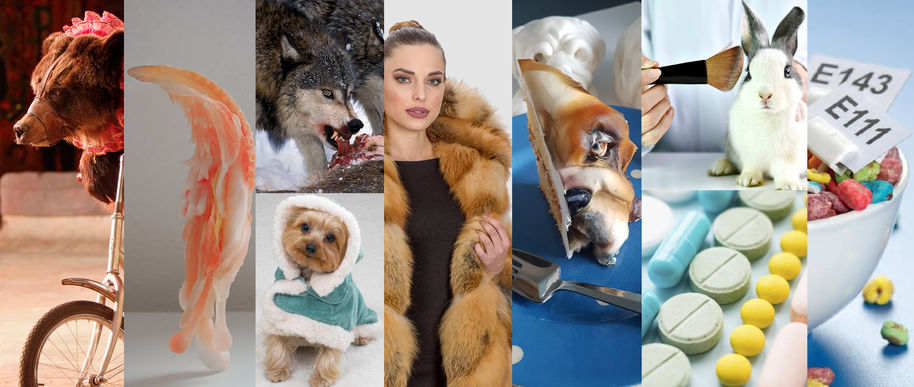
Visiting lecturers
We were lucky to have many inspiring visiting lecturers during the Critical Design Practise course. We picked up few links that we found interesting during the lecturers .
13.9.2018 Timo Rissanen - Fashion Micro utopias
Timo Rissanen is an author, designer and Assistant Professor of Fashion Design and Sustainability at the Parsons School of Design. He gave us inspiring lecture about Fashion micro utopias.
https://timorissanen.com/
Links:
localwisdom.info
https://www.kateraworth.com/doughnut/
friendsoflight.net
operationmigration.org
20.9.2018 Paola Antonelli - Broken Nature
Paola Antonelli is an author, editor and curator. the Milan Triennale 2019 Broken Nature.
http://www.brokennature.org/
27.9.2018 Carmen Hijosa - Ananas Anam
Carmen Hijosa is a designer and a founder of Ananas Anam company. She discover the use of pineapple leaves for an alternative to leather.
https://www.ananas-anam.com/
Useful links
Reading:
Aaltola Elisa, Eläinten moraalinen arvo (2004)
Grant Catharine, Eläinten oikeudet, No-nonsense Guide to Animal rights (2006)
Gunnarsson Karin, Eläinystävällisen kuluttajan opas, Animalia (1999)
Kivelä, Lahtinen, Uotila, Uusi eläinlaki (2017)
Singer Peter, Animal Liberation (1975)
Websites:
Videos:
Earthlings (2005) http://www.nationearth.com/ EARTHLINGS is a 2005 American documentary film about humankind’s total dependence on animals for economic purposes.
Kill it, skin it, wear it (2008) https://www.youtube.com/watch?v=lsG_B1TXsDs Merrilees Parker investigates the recent surge in popularity for fur and tries to find out whether the animals are killed humanely. Later on she goes beaver trapping and asks whether she could kill it, skin it and wear it.








